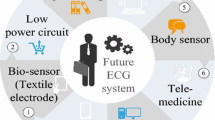Abstract
Even though it might be beneficial to have continuous baseline data upfront, today’s hospitalized patients are put on a vital signs monitor not earlier than they become bed-ridden. The aim of this study is to show the feasibility of a broader monitoring concept, embracing many more subjects, by monitoring contactless vital signs with sensors embedded in non-ICU settings. In order to conduct the experiments, a system was designed to measure electrocardiograms (ECG) unobtrusively by capacitive sensors in various patient fitments e.g., stretchers, hospital-beds and wheelchairs. Contact ECG and contactless ECG measurements by shielded textile electrodes are contrasted to each other to display the potential of contactless monitoring. Our experiments demonstrate that the contactless ECG recordings are of sufficient quality and later used for further standard ECG analysis like QRS-complex detection. We believe that our results are motivating for the potential future care facility featuring a personal, non-obtrusive and yet permanent health monitoring system.














Similar content being viewed by others
References
Afonso V, Tompkins W, Nguyen T, Luo S (1999) ECG beat detection using filter banks. IEEE Trans Biomed Eng 46(2):192–202
Aleksandrowicz A, Leonhardt S (2007) Wireless and non-contact ECG measurement system: the “Aachen Smartchair”. Acta Polytechnica Czech Tech Univ Publ House Prag 47(4–5):68–71
Betts RP, Brown BH (1976) Method for recording electrocardiograms with dry electrodes applied to unprepared skin. Med Bio Eng 14(3):313–315
Bronzino JD (2000) The biomedical engineering handbook. CRC Press LLC, Florida, pp 181–190
Burr-Brown corporation (1995) INA 116, an ultra-low input bias current instrumentation amplifier. Datasheet, pp 1–9
Chamadiya BK, Heuer S, Hofmann UG, Wagner M (2008) Towards a capacitively coupled electrocardiography system for car seat integration. In: IFMBE proceedings, vol 22. ECIFMBE 2008, September, pp 1217–1221
Chamadiya B, Wagner M, Wondrak W, Hofmann UG (2010) Active passenger safety by intelligent textile. In: 7th International conference on wearable micro and nano technologies for personalized healthcare, Berlin, Germany
Chamadiya B, Heuer S, Wagner M, Hofmann UG (2011) Textile capacitive electrocardiography for automotive environment. In: BIODEVICES 2011, international conference on biomedical electronics and devices, Rome, Italy, January, pp 422–425
Clippingdale AJ, Prance RJ, Clark TD, Watkins C (1994) Ultrahigh impedance capacitively coupled heart imaging array. Rev Sci Instrum 65:269–270
David RM, Portnoy WM (1972) Insulated electrocardiogram electrodes. Med Bio Eng 10:742
De Luca CJ, Le Fever RS, Stulen FB (1979) Pasteless electrode for clinical use. Med Bio Eng Comput 17:387
Eilebrecht B, Czaplik M, Walter M, Wartzek T, Rossaint R, Leonhardt S (2009) Implementation of a capacitive ECG measurement system in clinical practice: an interim report. IFMBE Proc 25:370–372
Harland CJ, Clark TD, Prance RJ (2002) Electrical potential probes: new directions in the remote sensing of the human body. Meas Sci Technol 13:163–169
Kim K, Lim Y, Park KS (2005) Common mode noise cancellation for electrically non-contact ECG measurement system on a chair. In: Proceedings of 2005 IEEE Engineering in Medicine and Biology. 27th Annual conference, September, Shanghai, China
Lee JM, Pearce F, Hibbs AD, Matthews R, Morrisette C (2004) Non-contact (through-clothing) electrode for ECG monitoring and life science detection for the objective force warfighter. In: Presented at the RTO HFM symposium on “Combat Casualty Care in Ground Based Tactical Situations: trauma technology and Emergency Medical Procedure” August, St. Pete beach, USA, pp 16–18
Lee K, Lee S, Sim K, Kim K, Park KS (2009) Noise reduction for non-contact electrocardiogram measurement in daily life. Comput Cardiol 36:493–496
Lim YG, Kim KK, Park KS (2007) ECG recording on a bed during sleep without direct kin-contact. IEEE Trans Bio Eng 54(4):718–725
Malmivuo J, Plonsey R (1995) Bioelectromagnetism, principles and applications of bioelectric and biomagnetic fields. Oxford University Press, New York, pp 16–19
Mankodiya K, Ali Hassan Y, Vogt S, Gehring H, Hofmann UG (2010) Wearable ECG module for long-term recordings using a smartphone processor. In: Proceedings of the 5th international workshop on ubiquitous health and wellness, UbiComp 2010, Copenhagen, Denmark
Metting van Rijn AC, Peper A, Grimbergen CA (1990) High quality recording of bioelectric events. I: Interference reduction, theory and practice. Med Biol Eng Comput 28(5):389–397
Pallas-Areny R, Webster JG (1999) Analog Signal Processing. Wiley-Interscience Publication, New York, pp 482–484
Prance RJ, Debray A, Clark TD, Prance H, Nock M, Harland CJ, Clippingdale AJ (2000) An ultra-low-noise electrical-potential probe for human-body scanning. Meas Sci Technol 11:291–297
Rich A (1983) Shielding and guarding, how to exclude interference-type noise, what to do and why to do: a rationale approach. Analog Dialog 17(1):124–129
Richardson PC (1967) The insulated electrode: a pasteless ECG technique. In: Proceedings of the 20th annual conference on engineering in medicine and biology. Boston, MA (USA), pp 157
Sörnmo L, Laguna P (2006) Electrocardiogram (ECG) signal processing. Wiley Encycl Biomed Eng 2:1298–1313
Spinelli E, Haberman M (2010) Insulating electrodes: a review on biopotential front ends for dielectric skin–electrode interfaces. Physiol Meas 31:183–198
The BioSig Project (2011) http://biosig.sourceforge.net/help/biosig/t300/nqrsdetect.html. Accessed on August 31
Wolfson RN, Neuman MR (1969) Miniature Si-SiO2 insulated electrode based on semiconductor technology. In: Proceedings 8th international conference medicine biological engineering. Chicago, Carl Gorr, Paper No. 14-6
Yip M, He DD, Winokur E, Balderrama AG, Sheridan R, Ma H (2009) A flexible pressure monitoring system for pressure ulcer prevention. Conf Proc IEEE Eng Med Biol Soc 2009:1212–1215
Acknowledgments
The authors would like to thank the BMBF (German Ministry for Education and Research) for funding the work of the INSITEX project. We are also thankful to TITV-Greiz, Greiz, Germany for providing us the textile-based contact electrodes. Our appreciations extend to Stephen Oung and Shivayogi Hiremath for their time and efforts on reviewing our manuscript.
Author information
Authors and Affiliations
Corresponding author
Additional information
B. Chamadiya and K. Mankodiya contributed equally.
Rights and permissions
About this article
Cite this article
Chamadiya, B., Mankodiya, K., Wagner, M. et al. Textile-based, contactless ECG monitoring for non-ICU clinical settings. J Ambient Intell Human Comput 4, 791–800 (2013). https://doi.org/10.1007/s12652-012-0153-8
Received:
Accepted:
Published:
Issue Date:
DOI: https://doi.org/10.1007/s12652-012-0153-8




